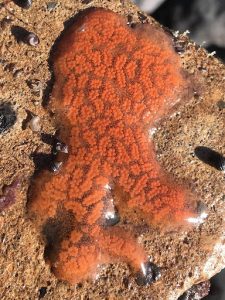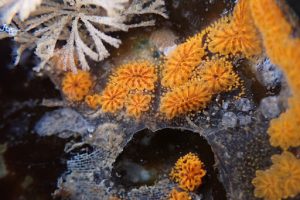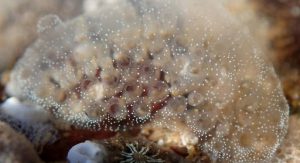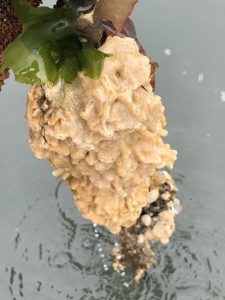Colonial Tunicates are small marine filter-feeding animals, sometimes referred to as sea squirts. They live attached to underwater objects. Their name is inspired by the thick, protective skin that coats their sac-like bodies, resembling a tunic. Colonies are made up of many individual organisms (zooids).
Colonial Tunicates usually grow in sheltered, low-current areas, attached to rocks, seaweeds, Eelgrass, and other native species, or on man-made structures such as ropes, docks, boat hulls and shellfish culture gear. They alter natural marine ecosystems by outcompeting native species for food and space. They also threaten coastal and offshore fishing and aquaculture activities by fouling aquaculture species and gear.
Botrylloides violaceus
Description: Native to the Northwest Pacific Ocean. Forms dense mats of many small individuals that are arranged in curving tracks. Colour varies from whitish, yellow, orange, reddish-brown, to violet.
Pathway: Present in Nova Scotia since the 1990s, pathway not definitively known.

Botryllus schlosseri
Description: Native to the Mediterranean Sea. Forms dense mats of star- or flower-shaped colonies made up of many small, daisy petal-shaped individuals. Colour varies from orange, yellow, red, greenish grey, violet, dark grey to black.
Pathway: Present in Nova Scotia since the 1980s, pathway not definitively known.

Diplosoma listerianum
Description: Native to Northern Europe. Forms dense, gelatinous, fragile colonies that are difficult to remove without tearing. Darkish grey in color, though they remain translucent. Openings sometimes have white spots.
Pathway: Has spread up the eastern coast of the United States, most likely from hull fouling.

Didemnum vexillum
Description: Native to the Pacific Ocean. Colonies are dense and resemble pancake batter. Dark lines may run randomly through them, and white spots may appear due to calcareous spicules embedded within.
Pathway: Not yet in eastern Canada, but present on the east coast of the United States.

Tunicates are said to eat their own brains during metamorphosis. Tunicate fossils date back as far as 540 million years ago – a time when plants were not yet found on land.
If boating or fishing in Tunicate-infested waters, keep your boat hull and gear clean to avoid accidentally transporting tunicates to new locations. Avoid transporting infested shellfish or water that may contain tiny bits of Tunicate to avoid accidental introductions into unaffected or less-affected areas. If you spot this invasive species, report the location to iNaturalist, or directly to the NSISC.
Join our mailing list.